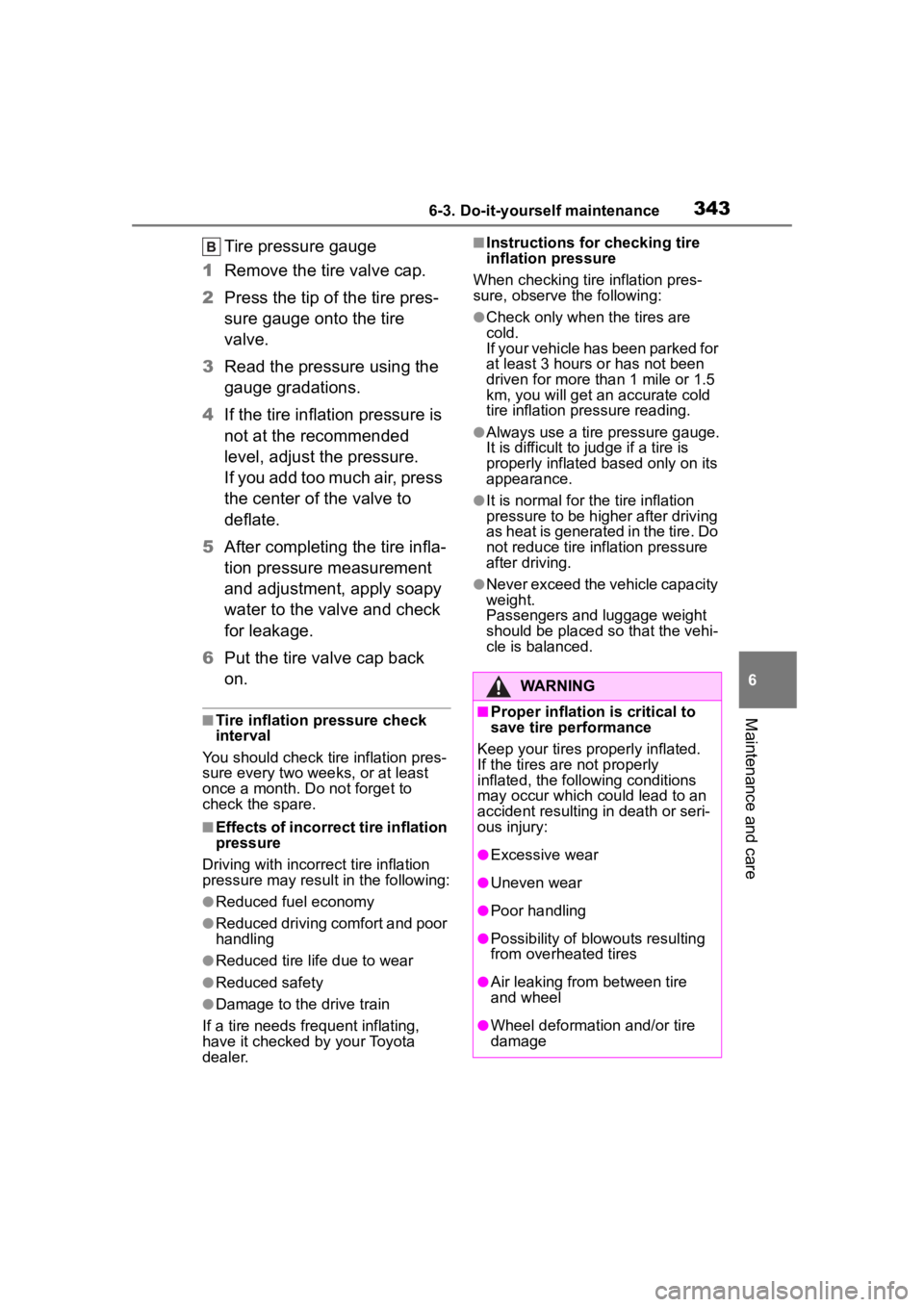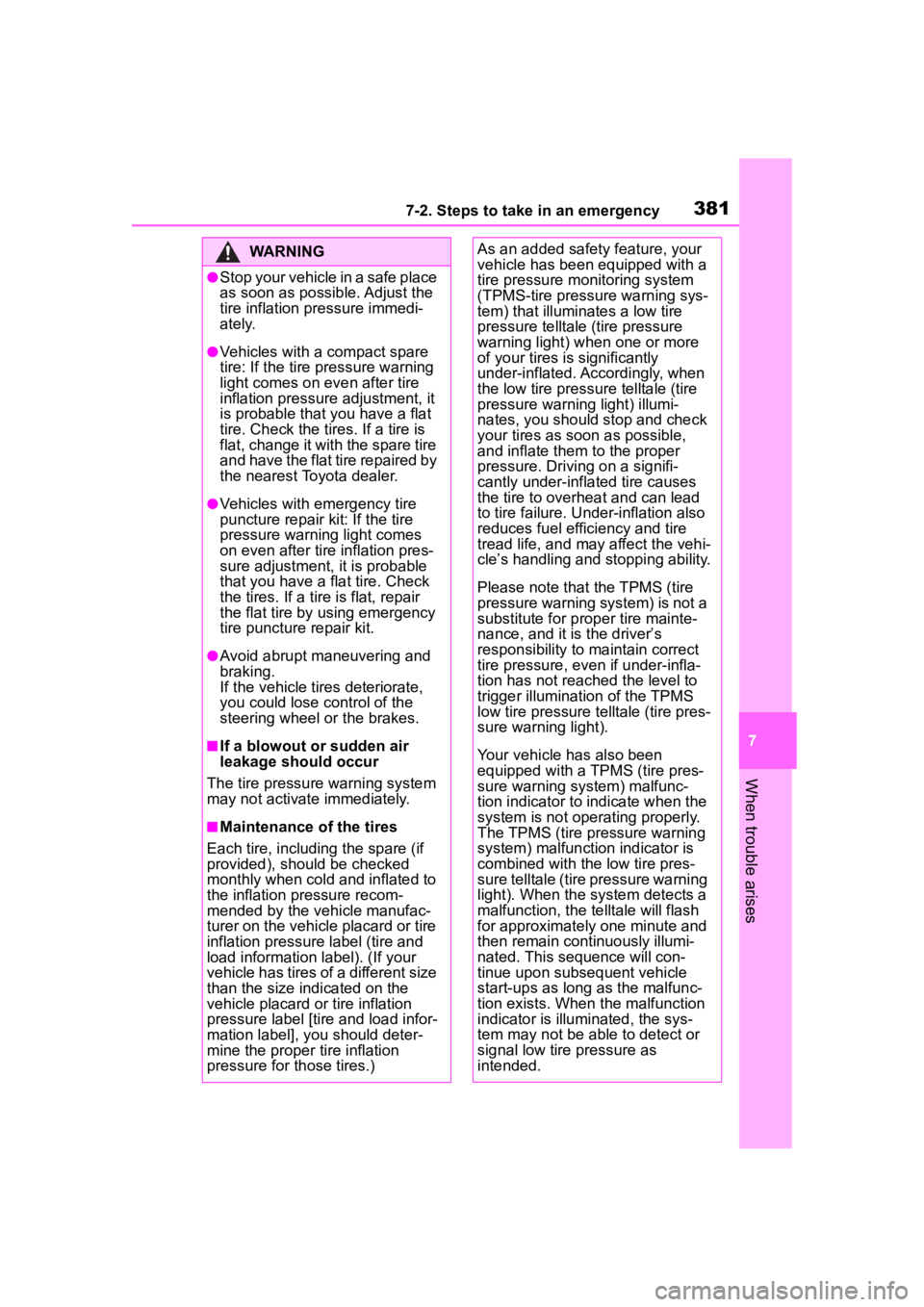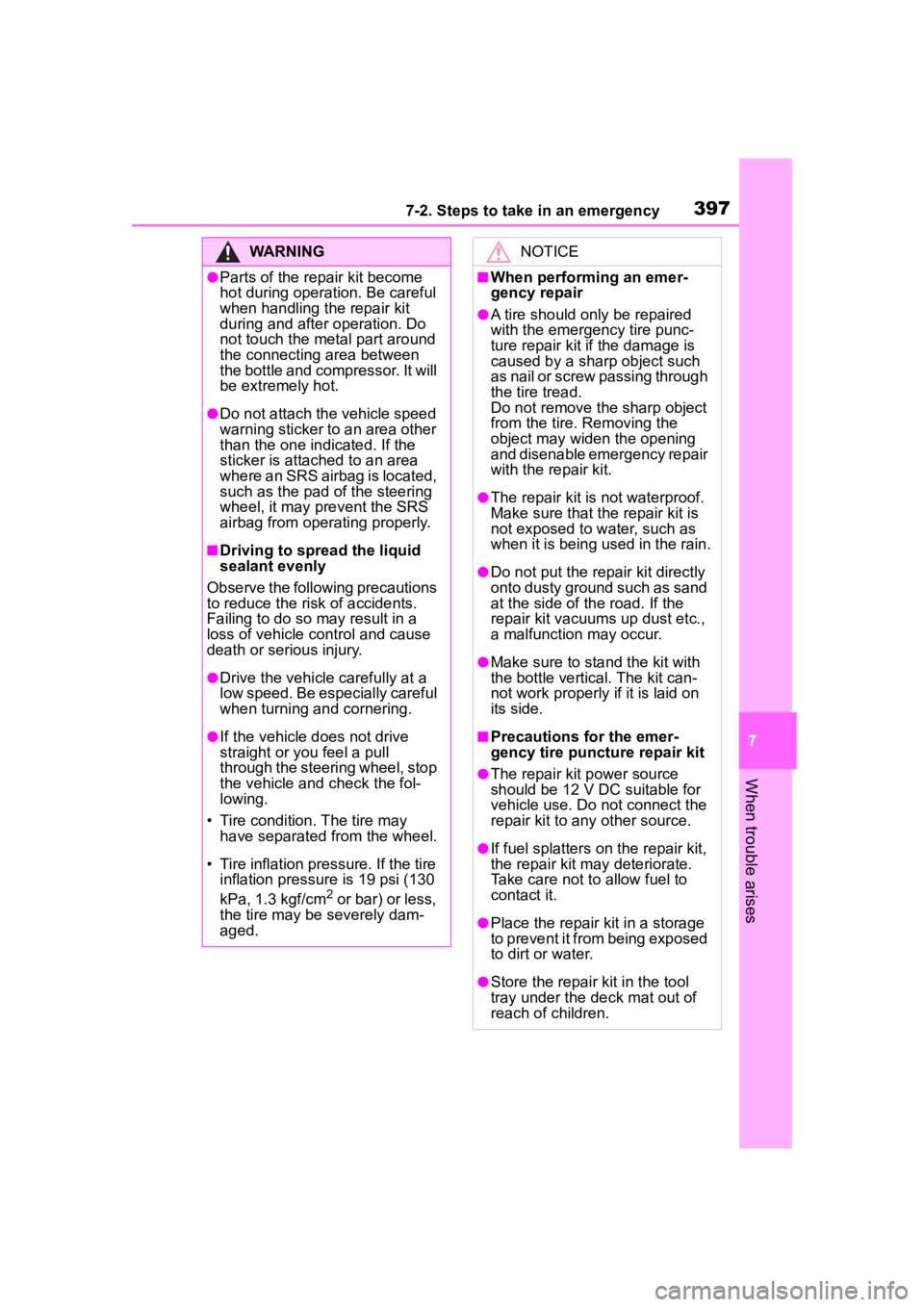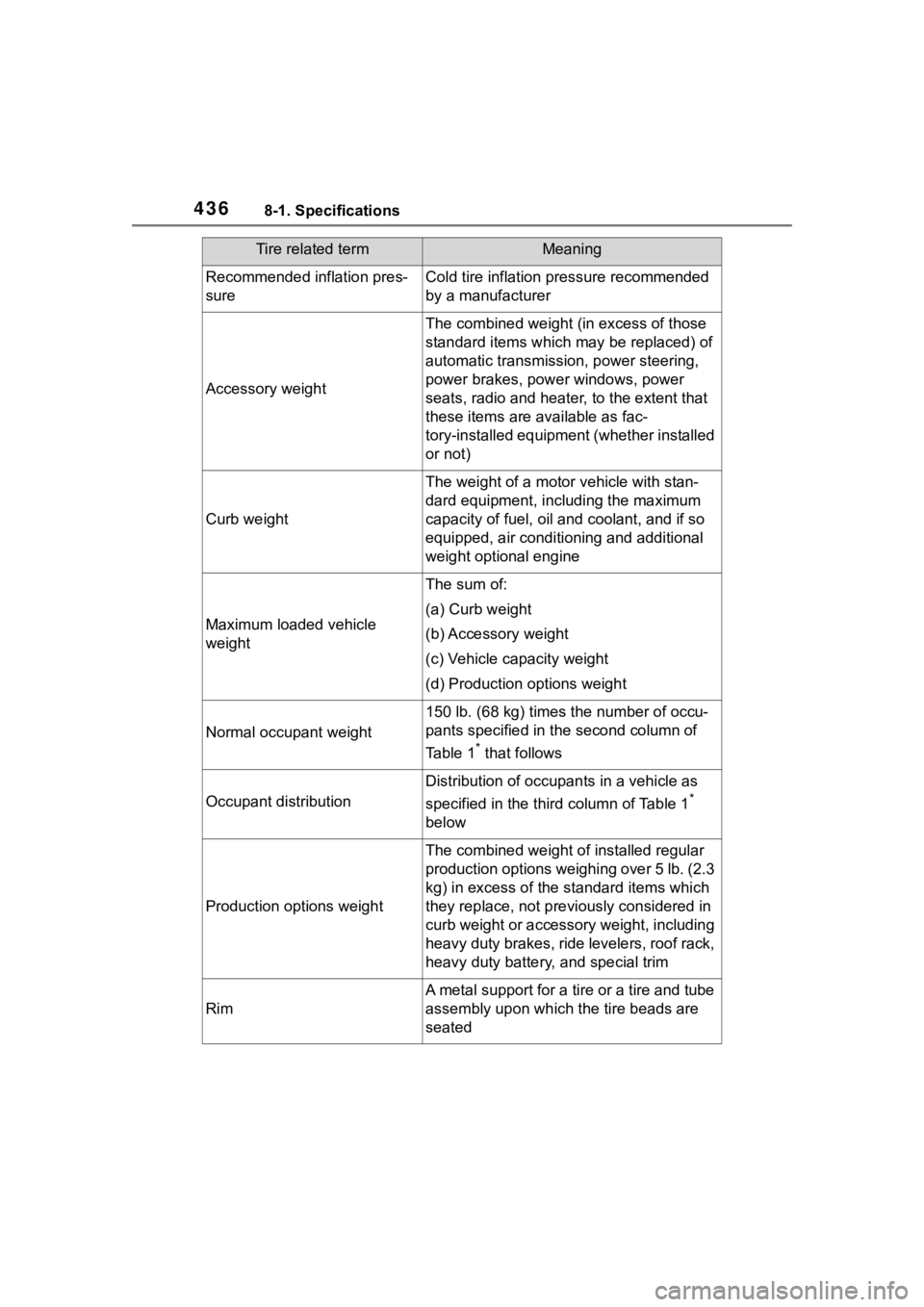2023 TOYOTA COROLLA HYBRID fuel pressure
[x] Cancel search: fuel pressurePage 343 of 496

3436-3. Do-it-yourself maintenance
6
Maintenance and care
Tire pressure gauge
1 Remove the tire valve cap.
2 Press the tip of the tire pres-
sure gauge onto the tire
valve.
3 Read the pressure using the
gauge gradations.
4 If the tire inflation pressure is
not at the recommended
level, adjust the pressure.
If you add too much air, press
the center of the valve to
deflate.
5 After completing the tire infla-
tion pressure measurement
and adjustment, apply soapy
water to the valve and check
for leakage.
6 Put the tire valve cap back
on.
■Tire inflation pressure check
interval
You should check tire inflation pres-
sure every two weeks, or at least
once a month. Do not forget to
check the spare.
■Effects of incorrect tire inflation
pressure
Driving with incorrect tire inflation
pressure may result in the following:
●Reduced fuel economy
●Reduced driving comfort and poor
handling
●Reduced tire life due to wear
●Reduced safety
●Damage to the drive train
If a tire needs frequent inflating,
have it checked by your Toyota
dealer.
■Instructions for checking tire
inflation pressure
When checking tire inflation pres-
sure, observe the following:
●Check only when the tires are
cold.
If your vehicle has been parked for
at least 3 hours or has not been
driven for more than 1 mile or 1.5
km, you will get an accurate cold
tire inflation pressure reading.
●Always use a tire pressure gauge.
It is difficult to j udge if a tire is
properly inflated based only on its
appearance.
●It is normal for the tire inflation
pressure to be higher after driving
as heat is generated in the tire. Do
not reduce tire inflation pressure
after driving.
●Never exceed the vehicle capacity
weight.
Passengers and luggage weight
should be placed so that the vehi-
cle is balanced.
WARNING
■Proper inflation is critical to
save tire performance
Keep your tires properly inflated.
If the tires are not properly
inflated, the following conditions
may occur which could lead to an
accident resulting in death or seri-
ous injury:
●Excessive wear
●Uneven wear
●Poor handling
●Possibility of blowouts resulting
from overheated tires
●Air leaking from between tire
and wheel
●Wheel deformation and/or tire
damage
Page 381 of 496

3817-2. Steps to take in an emergency
7
When trouble arises
WARNING
●Stop your vehicle in a safe place
as soon as possible. Adjust the
tire inflation pressure immedi-
ately.
●Vehicles with a compact spare
tire: If the tire pressure warning
light comes on ev en after tire
inflation pressure adjustment, it
is probable that you have a flat
tire. Check the tires. If a tire is
flat, change it with the spare tire
and have the flat tire repaired by
the nearest Toy ota dealer.
●Vehicles with emergency tire
puncture repair kit: If the tire
pressure warning light comes
on even after tire inflation pres-
sure adjustment, it is probable
that you have a flat tire. Check
the tires. If a tire is flat, repair
the flat tire by using emergency
tire puncture repair kit.
●Avoid abrupt maneuvering and
braking.
If the vehicle tires deteriorate,
you could lose control of the
steering wheel or the brakes.
■If a blowout or sudden air
leakage should occur
The tire pressure warning system
may not activate immediately.
■Maintenance of the tires
Each tire, including the spare (if
provided), should be checked
monthly when cold and inflated to
the inflation pressure recom-
mended by the vehicle manufac-
turer on the vehicle placard or tire
inflation pressure label (tire and
load information label). (If your
vehicle has tires of a different size
than the size indicated on the
vehicle placard or tire inflation
pressure label [tire and load infor-
mation label], you should deter-
mine the proper tire inflation
pressure for those tires.)
As an added safety feature, your
vehicle has been equipped with a
tire pressure monitoring system
(TPMS-tire pressure warning sys-
tem) that illuminates a low tire
pressure telltale (tire pressure
warning light) w hen one or more
of your tires is significantly
under-inflated. Accordingly, when
the low tire pressure telltale (tire
pressure warning light) illumi-
nates, you should stop and check
your tires as soon as possible,
and inflate them to the proper
pressure. Driving on a signifi-
cantly under-inflated tire causes
the tire to overhea t and can lead
to tire failure. Under-inflation also
reduces fuel efficiency and tire
tread life, and may affect the vehi-
cle’s handling and stopping ability.
Please note that the TPMS (tire
pressure warning system) is not a
substitute for proper tire mainte-
nance, and it is the driver’s
responsibility to m aintain correct
tire pressure, even if under-infla-
tion has not reached the level to
trigger illumination of the TPMS
low tire pressure te lltale (tire pres-
sure warning light).
Your vehicle has also been
equipped with a TPMS (tire pres-
sure warning system) malfunc-
tion indicator to indicate when the
system is not operating properly.
The TPMS (tire pressure warning
system) malfunction indicator is
combined with the low tire pres-
sure telltale (tire pressure warning
light). When the system detects a
malfunction, the te lltale will flash
for approximately one minute and
then remain continuously illumi-
nated. This sequence will con-
tinue upon subsequent vehicle
start-ups as long as the malfunc-
tion exists. When the malfunction
indicator is illuminated, the sys-
tem may not be ab le to detect or
signal low tire pressure as
intended.
Page 386 of 496

3867-2. Steps to take in an emergency
ual Supplement” for the mainte-
nance interval applicable to your
vehicle.
■If “Maintenance Required Visit
Your Dealer” is displayed
Indicates that all maintenance is
required to correspond to the driven
distance on the maintenance sched-
ule
*.
Comes on approximately 5000
miles (8000 km) after the message
has been reset. (The indicator will
not work properly unless the mes-
sage has been reset.) Perform the
necessary maintenance. Please
reset the message after the mainte-
nance is performed. ( P.309)
*: Refer to the separate “Scheduled
Maintenance” or “Owner’s Man-
ual Supplement” for the mainte-
nance interval applicable to your
vehicle.
■If “Engine Maintenance
Required Visit Your Dealer” is
shown
The engine or an engine component
is malfunctioning. Have the vehicle
inspected by your Toyota dealer
immediately.
■If a message that indicates the
need for visiting your Toyota
dealer is displayed
The system or part shown on the
multi-information display is malfunc-
tioning. Have the vehicle inspected
by your Toyota dealer immediately.
■If a message that indicates the
need for referring to Owner’s
Manual is displayed
●If “Engine Coolant Temp High” is
displayed, follow the instructions
accordingly. ( P.414)
●If any of the following messages
are displayed on the multi-infor-
mation display, it may indicate a
malfunction. Have the vehicle
inspected by you r Toyota dealer immediately.
• “Smart Key System Malfunction”
• “Hybrid System Malfunction”
• “Check Engine”
• “Hybrid Battery System Malfunc- tion”
• “Accelerator System Malfunction”
●If any of the following messages
are displayed on the multi-infor-
mation display, it may indicate a
malfunction. Immediately stop the
vehicle and contact your Toyota
dealer.
• “Braking Power Low”
• “Charging System Malfunction”
• “Oil Pressure Low”
●If any of the following messages
are shown on the multi-informa-
tion display, the vehicle may have
run out of fuel. Stop the vehicle in
a safe place and, if the fuel level is
low, refuel the vehicle. ( P. 8 2 )
• “Hybrid System Stopped”
• “Engine Stopped”
●If “Maintenance Required for Trac-
tion Battery Cooling Parts See
Owner's Manual” is shown, the fil-
ters may be clogged, the air intake
vent may be blocked, or there may
be a gap in the duct. Therefore,
perform the follo wing correction
procedure.
• Cleaning the hybrid battery (trac-
tion battery) air intake vents.
( P.347)
If the warning message is shown
even if the vents are cleaned,
have the vehicle inspected by
your Toyota dealer.
NOTICE
■If “High Power Consumption
Power to Climate Temporar-
ily Limited” is displayed fre-
quently
There is a possible malfunction
relating to the charging system or
the 12-volt battery may be deteri-
orating. Have the vehicle
inspected by you r Toyota dealer.
Page 397 of 496

3977-2. Steps to take in an emergency
7
When trouble arises
WARNING
●Parts of the repair kit become
hot during operation. Be careful
when handling the repair kit
during and after operation. Do
not touch the metal part around
the connecting area between
the bottle and compressor. It will
be extremely hot.
●Do not attach the vehicle speed
warning sticker to an area other
than the one indicated. If the
sticker is attached to an area
where an SRS airbag is located,
such as the pad of the steering
wheel, it may prevent the SRS
airbag from operating properly.
■Driving to spread the liquid
sealant evenly
Observe the following precautions
to reduce the risk of accidents.
Failing to do so may result in a
loss of vehicle control and cause
death or serious injury.
●Drive the vehicle carefully at a
low speed. Be especially careful
when turning and cornering.
●If the vehicle d oes not drive
straight or you feel a pull
through the steering wheel, stop
the vehicle and check the fol-
lowing.
• Tire condition. The tire may have separated from the wheel.
• Tire inflation pressure. If the tire inflation pressure is 19 psi (130
kPa, 1.3 kgf/cm
2 or bar) or less,
the tire may be severely dam-
aged.
NOTICE
■When performing an emer-
gency repair
●A tire should only be repaired
with the emergency tire punc-
ture repair kit if the damage is
caused by a sharp object such
as nail or screw passing through
the tire tread.
Do not remove th e sharp object
from the tire. Removing the
object may widen the opening
and disenable emergency repair
with the repair kit.
●The repair kit is not waterproof.
Make sure that the repair kit is
not exposed to water, such as
when it is being used in the rain.
●Do not put the repair kit directly
onto dusty ground such as sand
at the side of the road. If the
repair kit vacuums up dust etc.,
a malfunction may occur.
●Make sure to stand the kit with
the bottle vertical. The kit can-
not work properly if it is laid on
its side.
■Precautions for the emer-
gency tire puncture repair kit
●The repair kit power source
should be 12 V DC suitable for
vehicle use. Do not connect the
repair kit to any other source.
●If fuel splatters on the repair kit,
the repair kit may deteriorate.
Take care not to allow fuel to
contact it.
●Place the repair kit in a storage
to prevent it from being exposed
to dirt or water.
●Store the repair kit in the tool
tray under the d eck mat out of
reach of children.
Page 436 of 496

4368-1. Specifications
Recommended inflation pres-
sureCold tire inflation pressure recommended
by a manufacturer
Accessory weight
The combined weight (in excess of those
standard items which may be replaced) of
automatic transmission, power steering,
power brakes, power windows, power
seats, radio and heater, to the extent that
these items are available as fac-
tory-installed equipment (whether installed
or not)
Curb weight
The weight of a motor vehicle with stan-
dard equipment, including the maximum
capacity of fuel, oil and coolant, and if so
equipped, air conditioning and additional
weight optional engine
Maximum loaded vehicle
weight
The sum of:
(a) Curb weight
(b) Accessory weight
(c) Vehicle capacity weight
(d) Production options weight
Normal occupant weight
150 lb. (68 kg) times the number of occu-
pants specified in the second column of
Table 1
* that follows
Occupant distribution
Distribution of occupan ts in a vehicle as
specified in the thi rd column of Table 1
*
below
Production options weight
The combined weight o f installed regular
production options weighing over 5 lb. (2.3
kg) in excess of the s tandard items which
they replace, not previously considered in
curb weight or accessory weight, including
heavy duty brakes, ride levelers, roof rack,
heavy duty battery, and special trim
Rim
A metal support for a tire or a tire and tube
assembly upon which the tire beads are
seated
Tire related termMeaning
Page 470 of 496

470Alphabetical Index
How to start the hybrid system................................... 170, 172
Identification number ............ 421
If the hybrid sy stem will not start
........................................... 406
If your vehicle has to be stopped in an emergency................. 363
Ignition switch (power switch) ................................... 170, 172
Overheating.......................... 414
Power switch ................ 170, 172
Tachometer ............................ 96
Engine coolant Capacity ............................... 423
Checking .............................. 320
Preparing and c hecking before
winter.................................. 273
Engine coolant temperature gauge................................. 96, 99
Engine oil Capacity ............................... 422
Checking .............................. 318
Preparing and c hecking before
winter.................................. 273
Warning light ........................ 373
Engine switch (power switch) ....................................... 170, 172If your vehicle has to be stopped in an emergency................. 363
Enhanced VSC ........................ 266
EPS (Electric Power Steering) ............................................... 266Warning light ........................ 375
EV drive mode ........................ 178
EV Driving Ratio ............. 106, 112
EV indicator .............................. 78
EV Ratio .......................... 106, 112
Event data recorder (EDR)......... 8F
Flat tire Tire pressure w arning system
...........................................328
Vehicles with a spare tire......398
Vehicles with an emergency tire puncture repair ki t...............387
Floor mats .................................24
Fluid Brake ....................................425
Hybrid transmission ..............424
Washer .................................324
Front passenger occupant clas- sification system ....................41
Front seats Adjustment ...........................141
Cleaning ...............................305
Correct driving posture ...........25
Head restraints .....................144
Seat heaters ....... ..................284
Front side marker lights Light switch...........................189
Wattage ................................428
Front turn signal lights Replacing light bulbs ............357
Turn signal lever ...................182
Fuel Capacity ...............................421
Fuel gauge .......................96, 99
Information ......... ..................429
Refueling ..............................196
Type......................................421
Warning light.........................375
Fuel consumption Average fuel economy .. 104, 110
Current fuel consumption ...104, 11 0
Fuel economy ................. 104, 110
Fuel filler door Refueling ..............................196
Fuel gauge...........................96, 99
Page 473 of 496

473Alphabetical Index
Maintenance requirements... 308
Malfunction indicator lamp.... 373
Menu icons ..................... 102, 109
Meter Clock ................................ 96, 99
Indicators................................ 94
Instrument panel light control98, 101
Meter control switches . 103, 110
Meter light control ................. 101
Meters .............................. 96, 99
Multi-information display .... 102, 109
Settings ........................ 108, 114
Warning lights....................... 372
Warning message ................ 382
Mirrors Inside rear view mirror.......... 147
Outside rear view mirror defog-gers .................................... 280
Outside rear view mirrors ..... 148
Vanity mirrors ....................... 298
Moon roof Door lock linked moon roof oper-ation ................................... 153
Jam protection function ........ 153
Operation ............................. 153
Multi-information display Audio system-linked display107, 11 3
Clock .............................. 98, 102
Cruise control ....................... 245
Driving informatio n display . 103,
11 0
Driving support system informa- tion display ................. 107, 113
Dynamic radar cruise control 239
ECO Accelerator Guidance 104, 111
Eco score ..................... 104, 111
Energy monitor ..................... 116
EV Driving Ratio ........... 106, 112 EV Ratio ....................... 106, 112
Fuel economy ............... 104, 110
Hybrid System Indicator .......104
Menu icons ...................102, 109
Meter control switches.. 103, 110
Navigation system-linked display
................................... 107, 113
Settings ........................ 108, 114
Tire pressure ...... ..................328
Vehicle information display .107, 11 3
Warning message.................382
N
Navigation system-linked display ....................................... 107, 113
Noise from under ve hicle...........5
O
Odometer...........................97, 101
Odometer and trip meter display
Display change button ....97, 101
Display items ..................98, 101
Oil Engine oil..............................422
Rear differential oil................424
Open tray .................................290
Opener Fuel filler door.......................196
Hood .....................................316
Trunk ....................................134
Outside rear view mirrors Adjustment ...........................148
BSM (Blind Spot M onitor) .....249
Folding..................................149
Outside rear view mirror defog- gers ....................................280
RCTA function.......................254
Safe Exit Assist.....................260
Outside temperatur e ..........96, 99
Overheating.............................414
Page 478 of 496

478Alphabetical Index
Brake hold ............................ 379
Brake Override System ........ 374
Brake system ....................... 372
Charging system .................. 373
Drive-Start Control ............... 374
Electric power steering ......... 375
Engine .................................. 373
High coolant temperature ..... 372
Hybrid system ...................... 373
Hybrid system overheat ....... 373
Key reminder ........................ 171
LDA (Lane Departure Alert) 223, 377
Low engine oil pressure ....... 373
LTA (Lane Tracing Assist) ... 218, 377
Open door ......... ........... 129, 131
PDA (Proactive Driving Assist) ........................................... 377
Seat belt ....................... 375, 376
Warning label ............................ 82
Warning lights ........................ 372 ABS ...................................... 374
Brake hold operated indicator........................................... 379
Brake Override System ........ 374
Brake system ....................... 372
Charging system .................. 373
Cruise control indicator ........ 378
Drive-Start Control ............... 374
Driving assist information indica- tor ....................................... 378
Dynamic radar cruise control indicator.............................. 377
Electric power steering ......... 375
High coolant temperature ..... 372
Hybrid system overheat ....... 373
LDA indicator ........................ 377
Low engine oil pressure ....... 373
Low fuel level ....................... 375
LTA indicator ......................... 377
Malfunction indicator lamp ... 373 Parking brake indicator.........379
PDA indicator........................377
Pre-collision syst
em .............377
Seat belt reminder light 375, 376
Slip indicator .........................378
SRS ......................................374
Tire pressure ...... ..................376
Warning messages .................382
Washer Checking ..............................324
Preparing and checking before winter ..................................273
Switch ...................................194
Washing and waxing ..............302
Weight Cargo capacity .....................168
Load limits ............................168
Wheels .....................................344 Replacing .............................344
Size ......................................426
Window lock switch ...............152
Windows Power windows ....................150
Rear window defogger .........280
Washer .................................194
Windshield wiper de-icer .......282
Windshield wipers ..................194
Winter driving tips ..................273
Wireless charger.....................292
Wireless remote control Battery-Saving Function .......137
Locking/Unlocking ................124
Replacing the battery ...........350